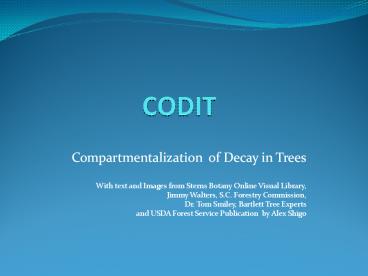CODIT - PowerPoint PPT Presentation
1 / 11
Title:
CODIT
Description:
Compartmentalization of Decay in Trees With text and Images from Sterns Botany Online Visual Library, Jimmy Walters, S.C. Forestry Commission, Dr. Tom Smiley ... – PowerPoint PPT presentation
Number of Views:34
Avg rating:3.0/5.0
Title: CODIT
1
CODIT
- Compartmentalization of Decay in Trees
- With text and Images from Sterns Botany Online
Visual Library, - Jimmy Walters, S.C. Forestry Commission,
- Dr. Tom Smiley, Bartlett Tree Experts
- and USDA Forest Service Publication by Alex
Shigo
2
(No Transcript)
3
CODIT (Compartmentalization Of Decay In
Trees) Four walls of defense against decay
pathogens Wall 1 Inhibits movement of decay
organisms in a vertical direction (weakest
wall). Wall 2 Inhibits movement of decay
organisms inward (second weakest). Wall 3 Ray
cells inhibit movement of decay around the stem
(strongest wall at the time of wounding). Wall 4
New wood formed by cambium after wounding
(strongest wall). From Jimmy Walters, SC
Forestry Commission
4
Wall 1. After being wounded, the tree responds
in a dynamic way by plugging the vertical
vascular system above and below the wound.
The conducting elements-vessels in angiosperms
and tracheids in Gymnosperms are plugged
in various ways tyloses, gum deposits pit
asperations, etc. The pIugged elements complete
the transverse top and bottom walls of
the compartments. Wall 1 is the
weakest wall. From Tree Decay an Expanded
Concept, USDA FORESTRY SERVICE publication by
Alex Shigo
5
Wall 2. The last cells to form in each growth
ring make up the tangential walls of the
compartments. These walls are CONTINUOUS
around each growth ring--except where sheets of
ray cells pass through. Wall 2 is the second
weakest wall. From Tree Decay an Expanded
Concept, USDA FORESTRY SERVICE publication by
Alex Shigo
6
Walls 3 are the strongest walls in the tree at
the me of wounding
Wall 3. Sheets of ray cells make up the radiaI
walls. They are, DISCONTINUOUS walls because they
vary greatly in length, thickness, and height.
Walls 3 are the strongest walls in the tree at
the time of wounding.
From Tree Decay an Expanded Concept, USDA
FORESTRY SERVICE publication by Alex Shigo
7
Wall 4. After a tree is wounded. the cambium
begins to form a new protective wall. The wall is
both an anatomical and a chemicaI wall. This wall
separates the tissue present at the time of
wounding new tissue that forms after. It is the
strongest of the four walls.
From Tree Decay an Expanded Concept, USDA
FORESTRY SERVICE publication by Alex Shigo
8
3
2
4
1
9
Wood Decay
From Jimmy Walters, SC Forestry Commission
10
Wood Response to Wounding
- Compartmentalization
- Four boundries
- 1. Up/Down - vessel plugging
- 2. Inward annual rings
- 3. Around rays
- 4. New wood
Dr. Tom Smiley Bartlett Tree Experts
11
Dr. Tom Smiley Bartlett Tree Experts































